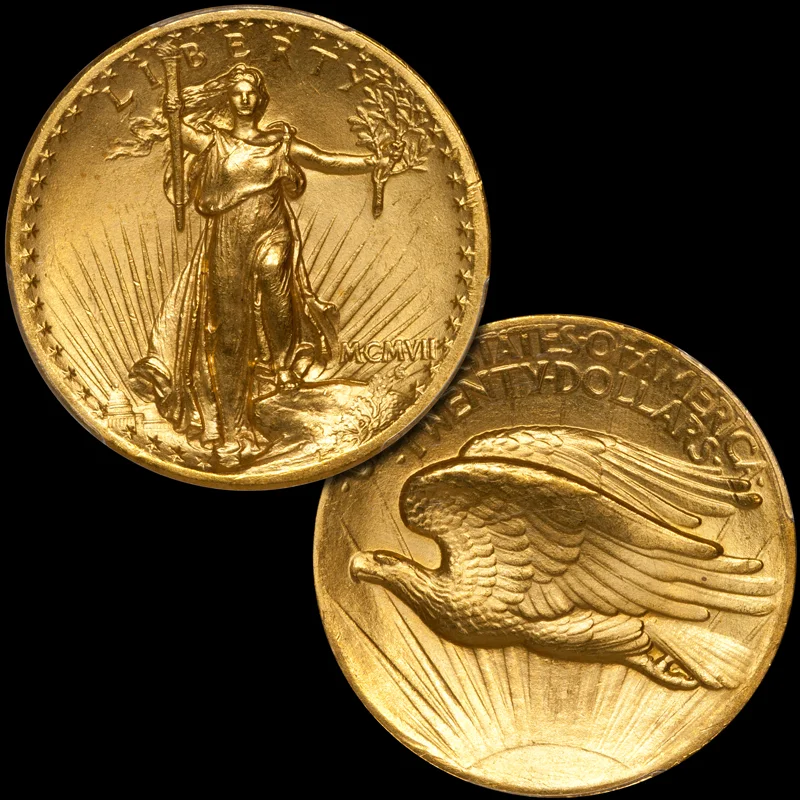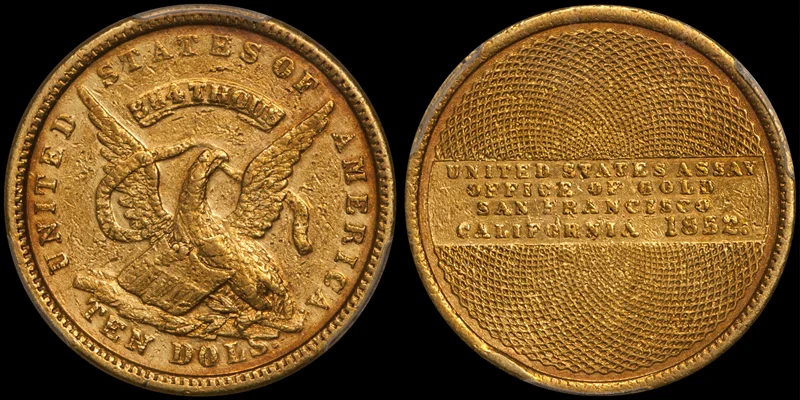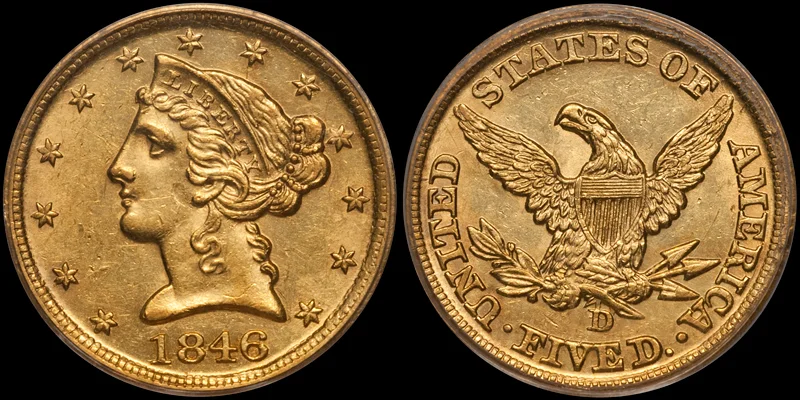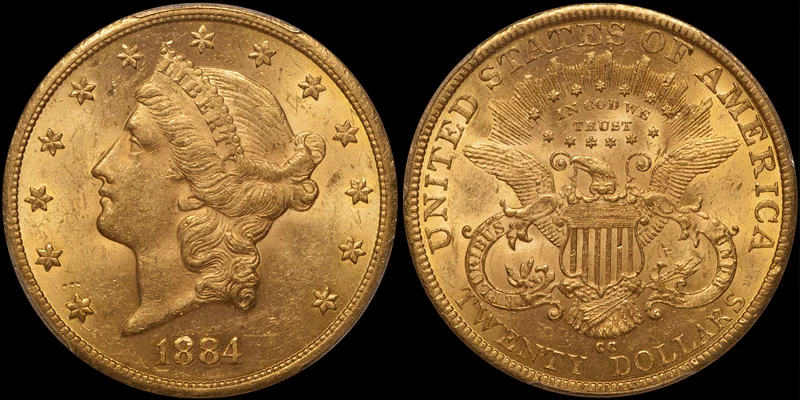Ten US Gold Coins Every Collector Should Own
/There are gold coins and there are Iconic Gold Coins. These are issues which due to their rarity, beauty, backstory, or date of issuance hold a special position in the heart of gold coin collectors. The following list is somewhat elitist by nature. Iconic Gold Coins aren’t cheap and if you have a $2,500 budget, you can still buy some really neat coins but none which I’d term “iconic.”
You’ll notice that this list is full of big, popular coins and it tends to omit specialized coins. If you ask me would I rather have an 1864-S half eagle in nice VF than a Gem High Relief, I’d pick the former. But I’m in the minority and I’d predict that 80-90% of the people reading this article would opt for the High Relief.
For many of these iconic coins (or coin types) I’m going to give some options which vary by price range. This won’t be possible for some ultra-specific issues but in these cases I’ll suggest the grade range which makes the most sense to me from a value perspective.
1. A PIECE OF PROOF GOLD
You can’t get much more macho than Proof gold when you list collecting areas. If a guy comes up to my table at a show and tells me he collects Proof gold by date or by type, he gets my undivided attention, and maybe even an invitation to dine with me that night.
Of course, very few collectors are working on date runs of Proof gold. But that doesn’t mean you can’t dabble. I feel that every US gold coin collection should have at least one piece of Proof gold.
1880 $1.00 NGC PR64CAM CAC, ex Eliasberg
At the $10,000 price point, there are some choices available. These would include common date gold dollars from the late 1880’s in PR65 CAM or DCAM, and PR64 CAM or DCAM common date quarter eagles from the late 1890’s through the end of the Liberty Head design in 1907. These aren’t especially glamorous but they are reasonably well-preserved coins which should have good overall eye appeal.
1895 $2.50 PCGS PR66DCAM CAC
If you can write a check for $25,000-35,000 you’ll be able to buy a nice example of a really rare date gold dollar or quarter eagle, or a borderline Gem “common date” three dollar. You’ll have to spend more to own a nice example of a Proof half eagle, eagle, or double eagle but you’ll own a big, impressive and rare coin which will be a highlight of your collection.
2. AN 18TH CENTURY GOLD COIN
Few numismatics items get the blood flowing faster than an 18th century gold coin. Three denominations were made during the 1795-1799 era: quarter eagles, half eagles and eagles. All the quarter eagles from this era are rare to very rare with a total mintage of just 2,916. It is unlikely that you you’ll be able to locate a problem-free coin (almost certainly a 1798 Wide Date) for less than $20,000.
recently sold 1798 Small 8 $5.00 PCGS EF45 CAC
Half eagles dated 1798 or 1799 are a realistic goal. I just offered a nice PCGS/CAC EF45 1798 Small 8 for $15,000 on my website and was inundated with inquiries. This price point will buy you a very presentable 1798 or 1799 $5, and $25,000 will be more than enough to acquire a really nice coin.
1799 Large Stars Obverse $10.00 PCGS AU55
The only semi-affordable 18th century ten dollar gold piece is the 1799. This date is abundant in EF and AU grades (with examples running in the $15,000-25,000 range), but most of the pieces available are low-end. There is a huge premium for nice CAC approved coins and even if you don’t buy into the stickering game, this is one issue where you’ll want to strongly consider paying up for a special coin.
3. A HIGH RELIEF
High Relief, PCGS MS64+ CAC, Flat Rim
High Reliefs are far more common than most collectors realize and a strong case can be made for calling them overrated/overpriced. But they are big, beautiful coins with a great background story and their level of demand always remains (sorry) high. In fact, they are probably the most liquid five-figure American gold coin.
Since there are so many available High Reliefs, can I suggest yours be somehow “special.” By this, I mean a coin with either a good pedigree or a coin with an unusual natural appearance. A CAC sticker is nice but it won’t make or break the sale-ability of a coin which is otherwise nice.
What grade is ideal for a High Relief? I personally recommend a coin in MS63 or MS64. Lower grade High Reliefs may not be attractive and most of the lower-grade Uncirculated pieces show rub or shiny spots on Liberty’s chest and front knee. A coin graded MS63 or MS64 should be truly “new” and it should have good eye appeal. Expect to pay $20,000-25,000 for an MS63, and $25,000-30,000+ for an MS64.
Two varieties are known: the Wire Edge and the Flat Edge. The latter is at least three times scarcer, but it commands just a small premium.
4. A PIECE OF TERRITORIAL GOLD FROM THE CALIFORNIA GOLD RUSH
The discovery of gold in California in 1848 led to the single greatest migration event in American history. Between 1848 and the opening of the US branch mint in San Francisco in 1854, a number of private minters produced gold coins in order to facilitate commerce in the booming Northern California economy.
A collector seeking a single nice example for his iconic coins set has a number of issues to choose from. In the $7,500-15,000 range he can purchase an 1849 or 1850 half eagle from Moffat and Co. or an 1852 Humbert/US Assay Office $10, or even an 1853 US Assay Office $20.
1852 $10.00 Assay PCGS AU50
To me, the very essence of a truly iconic Territorial gold coin is one of the $50 “slugs” struck by Augustus Humbert in 1851-1852, the US Assay Office in 1852 or Wass, Molitor in 1855. You’ll need to spend around $30,000-40,000 for an entry level piece; double this amount will buy you a significantly nicer coin or a rare variety.
5. A FINEST KNOWN OR A CONDITION CENSUS GOLD COIN
As a collector, it’s a matter of pride owning something that is “the finest.” In US gold coin collecting, it’s not always easy to state with certainty which specific coin(s) is the unquestioned best for its issue or design type. We can state with certainty that the Parmelee PCGS MS65 is the single finest 1796 No Stars quarter eagle, or that Parmelee-Jenks-Hayes-Pogue Gem 1808 quarter eagle is easily the best for the date and for the type. Conversely, it isn’t so easy to determine what the single best 1911-D quarter eagle is, or the best example of a semi-key St. Gaudens double eagle. That said, any chance to acquire a reasonably priced universally accepted finest known coin is not to be taken lightly.
1846-D/D $5.00 PCGS MS61 CAC, Condition Census
The term Condition Census refers to a listing of the five (or more) finest examples of a specific issue. Over the years I have done a lot of Condition Census research and my books (and articles on my website) contain Condition Census lists for many Liberty Head gold series.
Obviously, some finest known issues are extremely expensive. The two quarter eagles mentioned above are seven figure coins. But I sell finest known examples of less-glamorous 19th century branch mint issues from time to time in the $25,000-50,000+ range. And certain Condition Census issues are available from me (again, from time to time) for surprisingly reasonable sums. These will make great additions to an Iconic Coin Set.
6. AN ULTRA-LOW MINTAGE BUSINESS STRIKE GOLD
I consider a coin with 1,000 or fewer business strikes to have an “ultra-low mintage.” There are numerous 18th and 19th century issues which qualify as ultra-low mintage. Many of these are very rare and very expensive, but some are more available than one might think and are reasonably affordable as a result.
1873 $3.00 PCGS MS63
The following ultra-low mintage US gold coins can be bought in presentable grades for $10,000-20,000 (and in some cases less):
- 1875 gold dollar (mintage: 400)
- 1875 quarter eagle (mintage: 400)
- 1881 and 1885 quarter eagles (mintages: 640 and 800)
- 1873 three dollars (mintage: estimated 500+)
- 1880, 1884 and 1886 three dollars (mintages: 1,000 each)
- 1881, 1883 and 1885 three dollars (mintages: 500, 900, and 801)
- 1876 and 1877 ten dollars (mintages: 687 and 797)
If I had to select a favorite from among these thirteen issues, I’d be inclined to select a nice 1873 Three Dollar or an 1876 eagle.
7. A CARSON CITY DOUBLE EAGLE (AND PERHAPS MORE…)
If you collect US gold coins, the chances are good that you are fascinated by the history of the Old West. No other coin epitomizes this era better than a double eagle produced at the Carson City mint.
This facility struck gold coins in three denominations ($5, $10, and $20) from 1870 through 1893. Due to their size and relative availability, collectors like the double eagles best. They were produced in two distinct design types (Type Two from 1870 through 1876, and Type Three from 1877 through 1893) and they range in price from around $5,000 for a common date in nice AU grades to over $350,000 for a solid EF/AU 1870-CC.
1884-CC $20.00 PCGS MS62
If I were to recommend a single Carson City double eagle for an Iconic Coin Set, I’d likely suggest a common date Type Three such as an 1883-CC, 1884-CC, or 1890-CC in MS62. These were very difficult to locate a few years ago, but repatriated hoards from overseas have swelled the ranks of nice higher grade examples. A properly graded PCGS/CAC example should be available for less than $20,000.
People who buy one nice Carson City $20 often find it difficult to stop there. I’d suggest a nice Uncirculated CC $5 and a CC $10 to compliment the above-referenced $20.
8. A HIGH(ER) GRADE SOUTHERN GOLD COIN
I can’t see forming a set of Iconic US Gold Coins without including at least one high(er) grade Southern gold coin. The three southern mints that produced US gold coins were located at Charlotte, Dahlonega (GA), and New Orleans. The two mints which I would consider the most “southern” are Charlotte and Dahlonega.
Charlotte was operational from 1838 through 1861 and they struck gold dollars (in three different design types), quarter eagles (in two different design types), and half eagles (in four different design types). Dahlonega was also operational from 1838 through 1861 and they struck gold dollars (three design types), quarter eagles (two design types), three dollar gold pieces (one type only), and half eagles (four design types).
the famous 1861-D $1.00, this one graded PCGS AU55 CAC
There are many different paths to take when deciding which Southern gold coin to focus on. I would suggest a half eagle from either Charlotte or Dahlonega, and I would focus on a really nice common date issue in AU55 to AU58; such a coin is fairly easy to locate in the $4,000-8,000 range. A collector with a higher budget might look for a better date in MS62 or MS63; such a coin can be found with patience in the $20,000-40,000+ range.
If I were to choose the single most iconic southern gold coin it would be a toss-up between the 1861-D gold dollar and half eagle, and the 1854-D three dollar. All of these are rare issues with strong multiple levels of demand. And any of the three would make virtually anyone’s list of Most Iconic US Gold Coins.
9. A FAT HEAD HALF EAGLE
The Capped Head Left half eagle type, struck from 1813 to 1829 on large diameter planchets, and from 1829 through 1834 on reduced diameter planchets, features some of the rarest US gold issues ever produced. These tend to be “melt rarities,” which were created when the weight of all current gold coins was reduced in 1829 and nearly all issues from this era were melted as their intrinsic value was greater than their face value.
1813 $5.00 PCGS AU58 CAC
These issues are known to collectors as “Fat Heads” due to the Rubenesque depiction of Liberty on the obverse.
By a significant margin, the most available date for either design type is the 1813. This is followed by the next tier (which is all scarce to very scarce) including the 1814/3, 1818, 1820, and 1823. The next group of dates (1819, 1821, 1824, 1827, and 1830-1834) are all rare to very rare.
What’s a Fat Head going to cost? You can buy a nice AU 1813 for $10,000 or so and for $15,000-20,000 you can purchase a nice AU example of a better date (like an 1814/3, 1818, 1820 or 1823). A really sexy Fat Head half eagle will cost you at least $50,000-75,000+. No matter which road you choose to travel, this coin will likely become a highlight of your collection.
10. A COIN WITH A GREAT PEDIGREE
While not everyone will agree with this choice, to me an Iconic Gold Coin with an excellent provenance makes for a great addition to a set.
There are certain old collections which add value and cachet to individual coins. Some of these include Bass, Garrett, Eliasberg, Norweb, Pittman. But a great provenance doesn’t have to necessarily be from a famed collection. As an example, I recently sold a nice PCGS AU55 1805 half eagle which was accompanied by a very old coin envelope in which it had resided for many generations. We will never know the name of the collector, but the coin was made “fresher” and certainly a lot cooler by the presence of this mysterious piece of paper.
1805 $5.00 PCGS AU55 CAC, complete with its old paper envelope
There are a number of gold collections being formed today which will be highly-regarded by specialists in the future. With the high price of American gold coins, only the deepest pockets can put together a set as comprehensive as Eliasberg, Bass or Norweb. Today’s best pedigrees tend to be in the specialized arena. Perhaps your specialized collection (hello!!) will be highly sought after in 2038.
Hopefully you found this article to be helpful. I left a few seemingly obvious choices like a Stella or a Pan-Pac $50 off the list, but these could easily be added to an upscale Iconic Gold Coin Collection.
If you’d like to build a set of this caliber, please feel free to contact me via email at dwn@ont.com or call me at 214-675-9897.
























